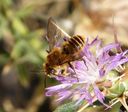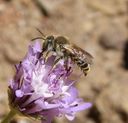Woodborer Bees
Lithurginae
Classification
- Phylum: Arthropoda
- Subphylum: Hexapoda
- Class: Insecta
- Order: Hymenoptera
- Family: Megachilidae
- Subfamily: Lithurginae
Pronunciation
How to pronounce Lithurginae: //laɪˈθɜːrdʒɪˌniː//
These audio files are automatically generated. While they are not always 100% accurate, they are a good starting point.
Images






Summary
Lithurginae is a subfamily of woodborer bees within the family Megachilidae, notable for their ecological roles as pollinators and their unique nesting habits involving burrowing into wood. Their distribution spans globally, with significant diversity in species and genera.
Physical Characteristics
Members of the subfamily Lithurginae, also known as woodborer bees, are characterized by their robust bodies adapted for burrowing into wood and plant materials. Their coloration can vary, often exhibiting dark or metallic hues.
Identification Tips
Look for these bees around wood sources, as they are known to bore into plant material. Their nesting behavior and physical adaptations for woodboring serve as key identification features.
Habitat
Lithurginae bees inhabit various environments where their host plants are available, commonly found in wooded areas, deserts, and regions with substantial plant material suitable for nesting.
Distribution
The subfamily Lithurginae is distributed worldwide with over 60 species in 3 genera globally. In our area, there are 7 species across 2 genera.
Diet
Lithurginae primarily feed on nectar and pollen from flowering plants. Their diet is similar to other bee species, leveraging floral resources for nourishment and larval food.
Life Cycle
The life cycle of Lithurginae includes egg, larval, pupal, and adult stages, with bees typically constructing nests in wood or plant stems where they can raise their young.
Reproduction
Lithurginae bees exhibit solitary nesting habits, with females typically laying eggs in prepared cavities made of wood or similar materials. This behavior includes provisioning their nests with pollen and nectar for larval development.
Ecosystem Role
As pollinators, Lithurginae bees contribute significantly to the ecosystem by aiding in the reproduction of various flowering plants. They also play a role in the decomposition process by boring into wood.
Economic Impact
The woodboring behavior of Lithurginae can have both positive and negative economic impacts; they aid in the pollination of crops while also potentially damaging wood resources.
Similar Taxa
Tags
- bees
- Lithurginae
- woodborer bees
- pollinators
- ecology